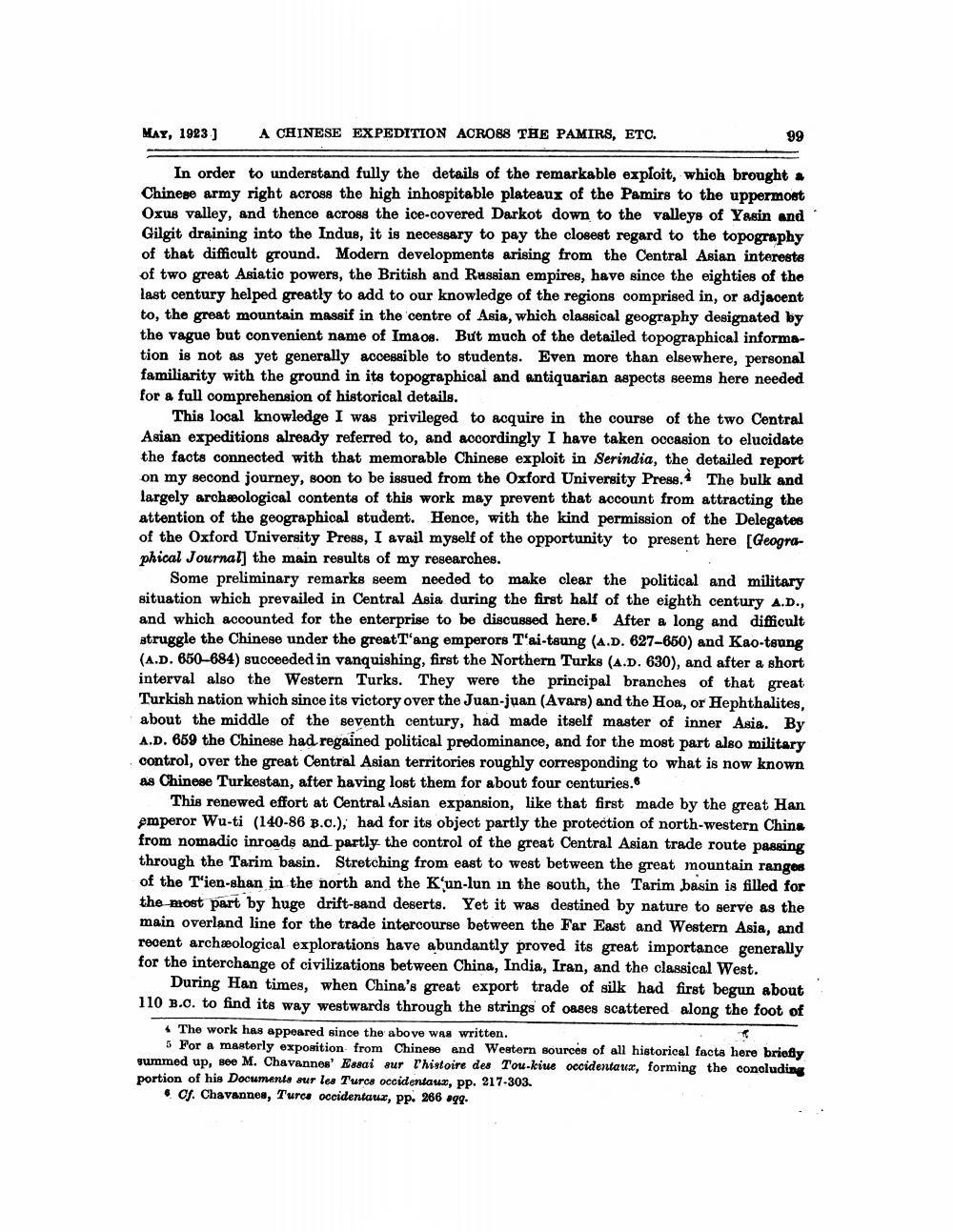________________
MAY, 1923 )
A CHINESE EXPEDITION ACROSS THE PAMIRS, ETC.
99
In order to understand fully the details of the remarkable exploit, which brought a Chinese army right across the high inhospitable plateaux of the Pamirs to the uppermost Oxus valley, and thence across the ice-covered Darkot down to the valleys of Yasin and Gilgit draining into the Indus, it is necessary to pay the closest regard to the topography of that difficult ground. Modern developments arising from the Central Asian intereste of two great Asiatic powers, the British and Russian empires, have since the eighties of the last century helped greatly to add to our knowledge of the regions comprised in, or adjacent to, the great mountain massif in the centre of Asia, which classical geography designated by the vague but convenient name of Imaos. But much of the detailed topographical information is not as yet generally accessible to students. Even more than elsewhere, personal familiarity with the ground in its topographical and antiquarian aspects seems here needed for a full comprehension of historical details.
This local knowledge I was privileged to acquire in the course of the two Central Asian expeditions already referred to, and accordingly I have taken occasion to elucidate the facts connected with that memorable Chinese exploit in Serindia, the detailed report on my second journey, soon to be issued from the Oxford University Press. The bulk and largely archeological contents of this work may prevent that account from attracting the attention of the geographical student. Hence, with the kind permission of the Delegates of the Oxford University Press, I avail myself of the opportunity to present here [Geographical Journal] the main results of my researches
Some preliminary remarks seem needed to make clear the political and military situation which prevailed in Central Asia during the first half of the eighth century A.D., and which accounted for the enterprise to be discussed here. After a long and difficult atruggle the Chinese under the great Tang emperors T'ai-tsung (A.D. 627-650) and Kao-tsung (A.D. 650-684) succeeded in vanquishing, first the Northern Turks (A.D. 630), and after a short interval also the Western Turks. They were the principal branches of that great Turkish nation which since its victory over the Juan-juan (Avars) and the Hoa, or Hephthalites, about the middle of the seventh century, had made itself master of inner Asia. By A.D. 659 the Chinese had regained political predominance, and for the most part also military control, over the great Central Asian territories roughly corresponding to what is now known As Chinese Turkestan, after having lost them for about four centuries.
This renewed effort at Central Asian expansion, like that first made by the great Han emperor Wu-ti (140-86 B.C.), had for its object partly the protection of north-western Chine from nomadic inroads and partly the control of the great Central Asian trade route passing through the Tarim basin. Stretching from east to west between the great mountain ranges of the T'ien-shan in the north and the Kun-lun in the south, the Tarim basin is filled for the most part by huge drift-sand deserts. Yet it was destined by nature to serve as the main overland line for the trade intercourse between the Far East and Western Asia, and recent archaeological explorations have abundantly proved its great importance generally for the interchange of civilizations between China, India, Iran, and the classical West.
During Han times, when China's great export trade of silk had first begun about 110 B.o. to find its way westwards through the strings of Oases scattered along the foot of
The work has appeared since the above was written.
5 For a masterly exposition from Chinese and Western sources of all historical facts here briefly gummed up, see M. Chavannes' Essai sur l'histoire des Tou-kiue occidentaux, forming the concluding portion of his Documents sur les Turcs occidentaux, pp. 217-303.
. Cf. Chavannes, Turca occidentaux, pp. 266 199.




